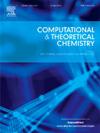Thermochemistry of demethylation of methoxy groups in aromatic compounds: Applicability of DFT, G4, and G4(MP2) methods
IF 3
3区 化学
Q3 CHEMISTRY, PHYSICAL
引用次数: 0
Abstract
This work analyses O![]() C bond dissociation enthalpies (BDE) of aromatic compounds. BDE values were calculated for 23 meta- and para-substituted anisoles, together with polymethoxybenzenes and naturally occurring coumarins, using three theoretical methods: M06-2X, G4, and G4(MP2). Electron-donating groups decrease the O
C bond dissociation enthalpies (BDE) of aromatic compounds. BDE values were calculated for 23 meta- and para-substituted anisoles, together with polymethoxybenzenes and naturally occurring coumarins, using three theoretical methods: M06-2X, G4, and G4(MP2). Electron-donating groups decrease the O![]() C BDE values, while electron-withdrawing groups increase them. The G4 and M06-2X methodologies show excellent agreement with experimental data, although M06-2X tends to overestimate BDEs. The applicability of other functionals was also assessed. G4 data for studied anisoles and phenols confirm that substituent effect on O
C BDE values, while electron-withdrawing groups increase them. The G4 and M06-2X methodologies show excellent agreement with experimental data, although M06-2X tends to overestimate BDEs. The applicability of other functionals was also assessed. G4 data for studied anisoles and phenols confirm that substituent effect on O![]() C BDEs of anisoles and O
C BDEs of anisoles and O![]() H BDEs of phenols is identical. Found Hammett-type dependences can be employed for the gas-phase BDE estimations for anisoles and phenols possessing other substituents with known σm and σp+ constants. Obtained results also emphasize the accuracy and computational efficiency of the G4(MP2) method and its applicability for the investigation of demethylation thermochemistry of larger molecules.
H BDEs of phenols is identical. Found Hammett-type dependences can be employed for the gas-phase BDE estimations for anisoles and phenols possessing other substituents with known σm and σp+ constants. Obtained results also emphasize the accuracy and computational efficiency of the G4(MP2) method and its applicability for the investigation of demethylation thermochemistry of larger molecules.

求助全文
约1分钟内获得全文
求助全文
来源期刊

Computational and Theoretical Chemistry
CHEMISTRY, PHYSICAL-
CiteScore
4.20
自引率
10.70%
发文量
331
审稿时长
31 days
期刊介绍:
Computational and Theoretical Chemistry publishes high quality, original reports of significance in computational and theoretical chemistry including those that deal with problems of structure, properties, energetics, weak interactions, reaction mechanisms, catalysis, and reaction rates involving atoms, molecules, clusters, surfaces, and bulk matter.
 求助内容:
求助内容: 应助结果提醒方式:
应助结果提醒方式:


